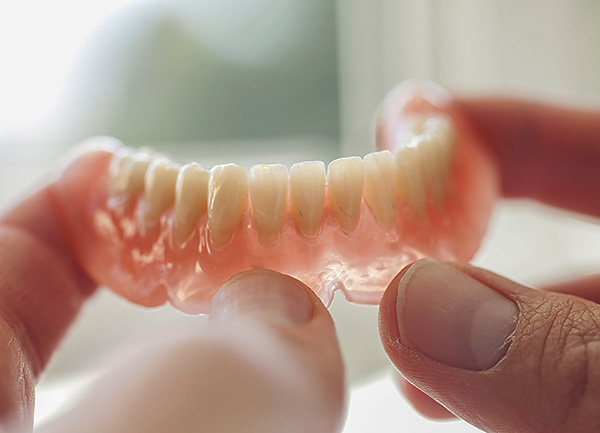
Today, people have a largely negative attitude to removable dentures - many associate them with “false jaws”, which must be removed at night and stored in a glass of water. It is generally accepted that they are very uncomfortable to wear, impair diction and may even fall out of the mouth when eating or talking.
Well, all these “horror stories” are not without definite reasons, but to a large extent they are remnants of the Soviet era, when the situation with the quality of manufactured dentures was far from the best.
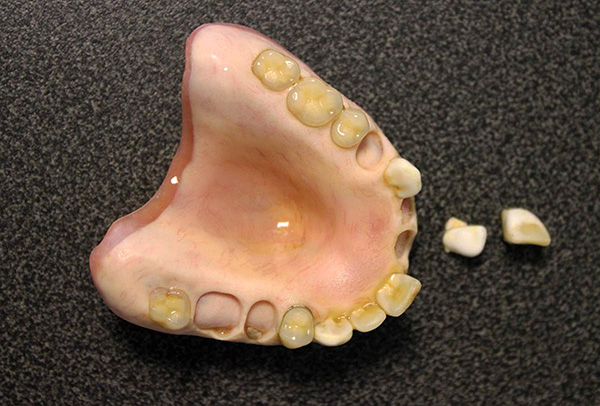
On a note
As the name implies, a complete denture is called a denture that is used in the complete absence of teeth in the oral cavity. Such prostheses are removable - when the patient himself can remove them (for example, for carrying out hygiene procedures), and conditionally removable - when the denture can only be removed by a doctor using special tools.
Fortunately, medicine does not stand still, and today even with the complete absence of teeth in the oral cavity, quite convenient orthopedic solutions can be found that will not only restore the ability to chew food normally, but also restore the long-lost beauty of a smile.
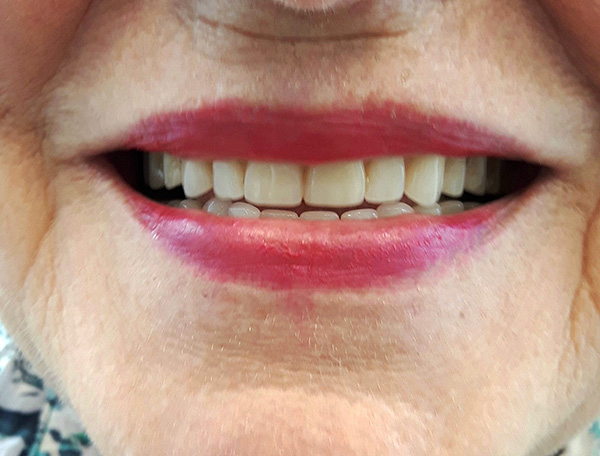
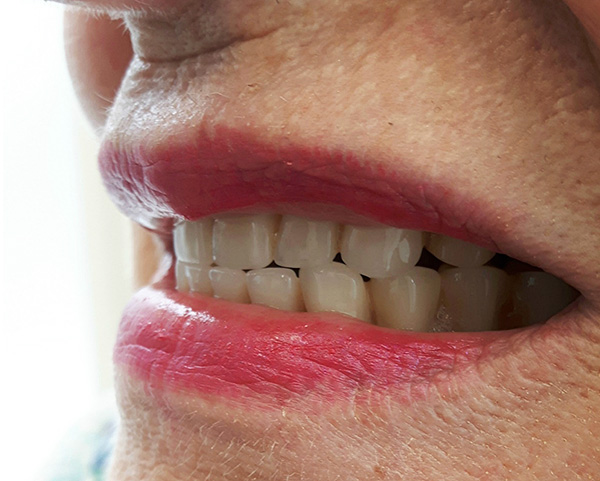
And last but not least, a complete denture today does not have to be uncomfortable to wear, rub your gums, cause a gag reflex or disrupt diction. For example, there are conditionally removable dentures without a palate, fixed on implants, which radically change the idea of the possibilities of prosthetics in “toothless” patients. The combination of surgical and orthopedic treatment allows not only to improve the aesthetic qualities of prostheses, but also to ensure their reliable fixation while significantly improving the functional characteristics that provide comfort during meals, talking, singing, etc.
There are interesting options for prosthetics even without implantation, when for a relatively small amount you can get a very convenient and outwardly attractive complete removable denture.
We’ll talk about all this in more detail later ...
What varieties of complete removable dentures are in the arsenal of dentists
Full removable prosthetics is considered one of the most difficult areas of orthopedics - because the prosthesis needs to be somehow fixed in the oral cavity, where, it would seem, there is simply nothing to fix it for. Partial removable dentures can be attached to the remaining (abutment) teeth, but with full dentures you have to look for alternative methods of attachment.
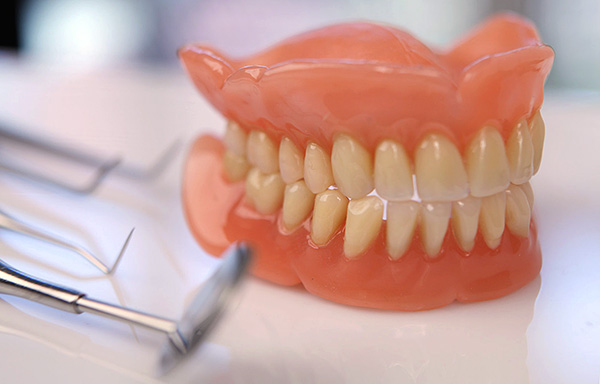
In this case, the orthopedic dentist has to consider the following nuances:
- Causes of tooth loss. For example, difficulties with complete removable prosthetics can occur when teeth are removed on the background of severe generalized periodontitis (the situation is much easier with the planned removal of relatively strong “roots” that cannot be restored);
- Time since tooth extraction. If all the teeth were removed a long time ago (for example, more than 10 years ago), the degree of atrophy of the bone tissue of the alveolar process of the jaw will be significant, and the conditions of the prosthetics worse than if it was carried out soon after tooth extraction (1-2 years);
- Past and ongoing diseases and operations on the jaw. A number of somatic diseases (especially severe ones) can worsen the conditions of a full removable prosthetics, forcing an orthopedic dentist to look for suitable alternatives.This applies primarily to elderly patients and people with combined pathologies (blood diseases, endocrine pathologies, oncological, musculoskeletal, etc.).
When prosthetics, an orthopedic dentist takes into account the condition of the temporomandibular joint (TMJ), mucous membranes (their suppleness, mobility), the degree of atrophy of the bone tissue, checks the condition of the cords and the presence of scars, as well as the depth of the sky (deep, medium, flat) and a number of other factors that, in the case of the manufacture of a complete denture, can play a decisive role.
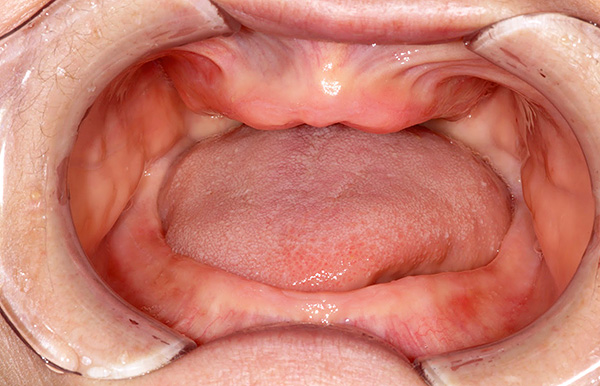
On a note
Having determined the conditions of a complete removable prosthetics (favorable or complex) and the financial capabilities of the patient, the doctor can offer the best option for the future prosthesis, explaining the pitfalls of each of the possible options.
It is clear that not everyone will be able to afford complete prostheses without a sky with fastening on implants (that is, conditionally removable), although they are as convenient and aesthetic as possible. When choosing more budget options, it makes sense to give preference, if, again, financial opportunities, to products made from the most modern materials. The least comfortable dentures made of hard acrylic plastic.
Complete removable dentures, depending on the material used in their manufacture, are:
- Acrylic
- Nylon
- Silicone;
- Polyurethane
All these removable dentures are fixed in the oral cavity due to the adhesion mechanism (they are attached to the palate and gums - therefore they are sometimes called dentures on the suction cups, although there are no suction cups as such in their design).
The photographs below show freshly made dentures made of nylon (full on the upper jaw and partial on the lower):
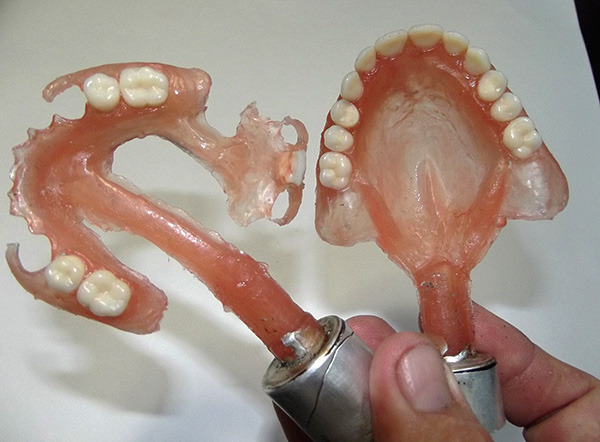
As for the types of attachment of conditionally removable prostheses fixed on implants installed in advance, the following options are distinguished here:
- Cover;
- Push-button;
- With beam clamps.
Each of the dentures, starting from the simplest (acrylic) and ending with any conditionally removable, has its advantages and disadvantages. The choice of option depends on the financial capabilities of the patient. It is important to keep in mind that regardless of the type of denture selected, the outcome of the treatment will directly depend on the level of training of the orthopedic surgeon, dental technician, and material and technical support of the clinic.
From the practice of the dentist
If you go to order a prosthesis in dentistry in the basement of an apartment building, where the doctor takes crowns from the “provider” wrapped in a fist from newsprint, it is difficult to count on first-class work. In very many cases, patients then cannot get used to such prostheses - due to manufacturing errors, they greatly interfere and rub the mucous membrane. As a result, the prosthesis is dusting on the shelf, as the patient does not wear it.
Full removable dentures made of acrylic plastic
The first manufacturing techniques for complete removable prostheses made of acrylic plastic (AKR-7) were introduced in the early 1940s and are still widely used in the production of bases of various modern designs in orthopedic dentistry.
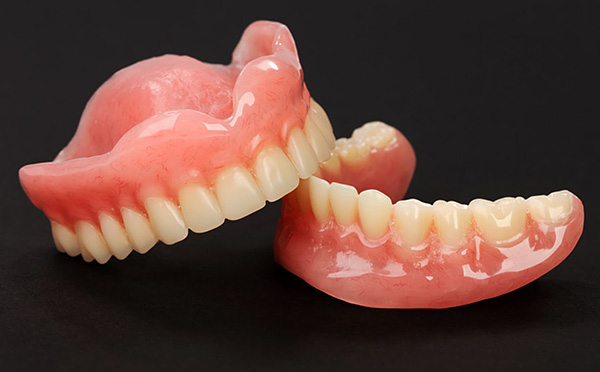
A base is the base of a complete removable denture on which artificial teeth are fixed. On the upper jaw, the basis is a plate covering the mucous membrane of the hard palate and alveolar process, and on the lower jaw, the mucous membrane of the alveolar part from the outside and inside.
On a note
For the reason that the basis of a complete removable denture is a plate, such dentures are also called laminar.
A complete removable denture does not have the ability to "cling" to the teeth, as they are completely absent.Therefore, these constructions on the upper jaw use the “suction” effect to the sky, as well as a certain anti-displacement effect that provide the natural anatomical folds and the alveolar ridge.
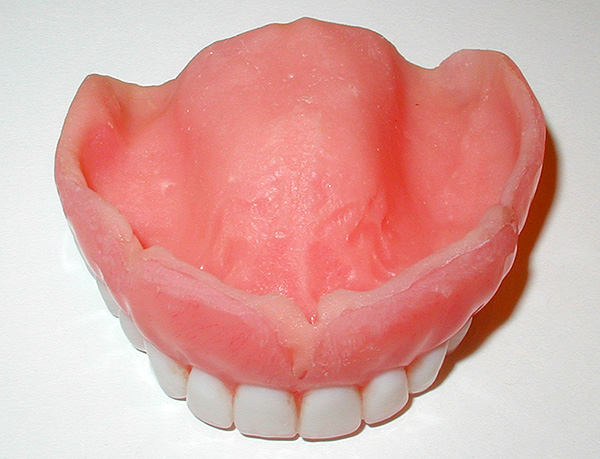
The lower jaw prosthesis does not have such a large “suction” area as in the case of the upper jaw prosthesis adjacent to the sky. The design is held at the expense of natural anatomical formations - largely due to the tight fit to the alveolar part.
Among the advantages of a full removable acrylic denture are:
- Low price in comparison with other designs;
- Possibility of repair for various types of damage;
- Ease of operation;
- Acceptable aesthetics, given the relatively low check for the service.
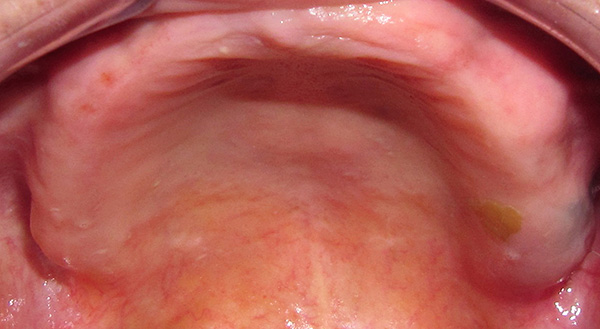
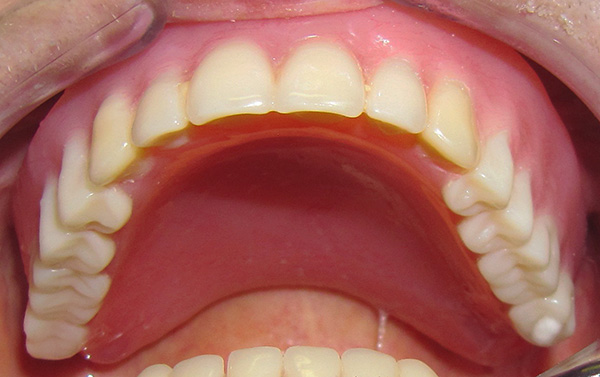
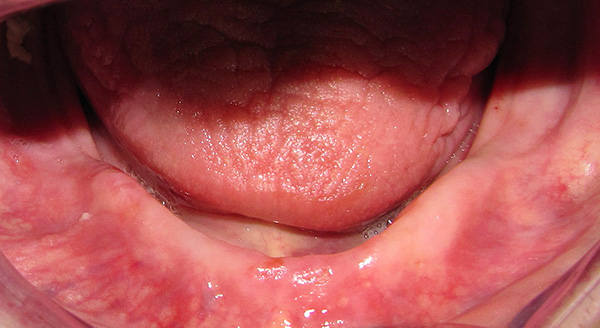
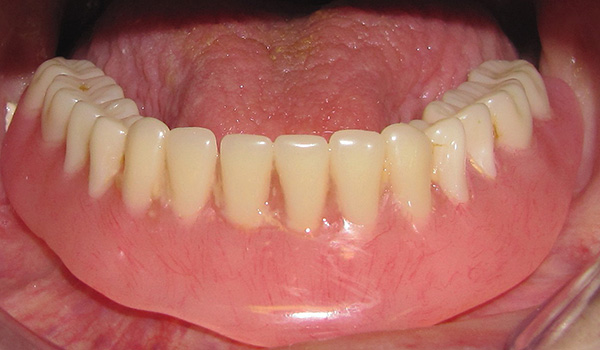
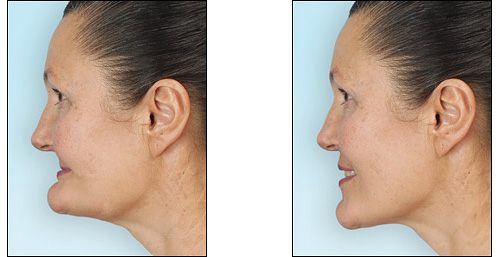
However, these prostheses are not without serious flaws:
- Allergy to residual monomer in acrylic bases (although in more expensive options there are ways to exclude monomer from plastic);
- The relative fragility of the plastic and the risk of fracture with a large simultaneous load;
- Low elasticity due to hard acrylic plastic;
- Frequent inconsistency of the relief of the inner surface of the base with the prosthetic bed of the mucous membrane (as a result, the reliability of fixation of the structure in the oral cavity is reduced).
On a note
Acrylic prostheses can be quite high-tech. For example, in 2015, technologies of the Swiss company “CANDULOR” appeared in Russia, proposing a line of high-quality acrylic removable dentures. High esthetics is achieved, including through the use of plastic, which imitates in detail the gingival capillary system.
The situation is similar with dentures based on other polymers (polyurethane, silicone, nylon): there are low-cost products, and there are also more expensive and technological ones. For example, for the manufacture of the basis of a complete removable denture, the material “Dentalur” based on polyurethane can be used. He was awarded the Gold Medal of the Ninth International Forum of High Technologies of the 21st Century and other awards. Dentalur dentures are durable, fairly flexible (comfortable due to this) and have a significant cosmetic advantage over standard dentures made of acrylic plastics.
Nylon dentures: their pros and cons
Full removable dentures from nylon are today, perhaps, at the peak of their popularity over the past 10 years - and there are a number of reasons for this.
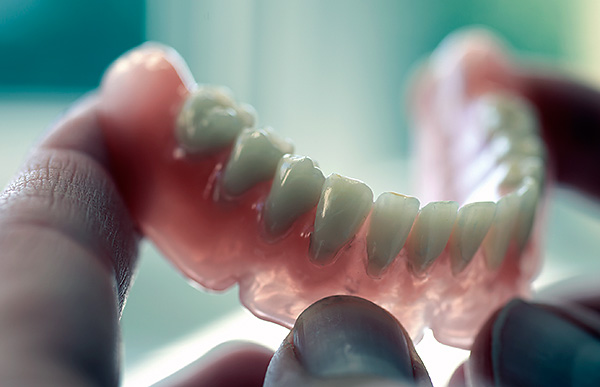
Here are some of the main advantages of nylon prostheses:
- No allergies to material. In the case of using a nylon prosthesis, unlike acrylic, there is no risk of developing an allergic reaction to the plastic monomer. Against this background, nylon wins greatly in comparison with acrylic plastic, especially in full removable prosthetics;
- High aesthetic performance. This parameter could even be put in the first place. Compared to the same acrylic dentures, nylon ones look “rich”, and, if one can say so with respect to a complete denture, it’s gorgeous (it is not for nothing that they are sometimes called invisible prostheses);
- Comfort while wearing. In most cases, these prostheses are easier to get used to and adapt to than standard acrylic ones;
- Resistance to mechanical damage. This quality is largely due to some elasticity of the prosthesis - it is not fragile, unlike acrylic plastic. It’s quite difficult to break a nylon prosthesis or somehow severely damage it.
On a note
In fairness, it must be said that advertising plays an important role in increasing the popularity of nylon removable dentures. These products are significantly more expensive than acrylic dentures, and dental clinics, of course, are more profitable for the patient to prefer a prosthesis made of nylon.
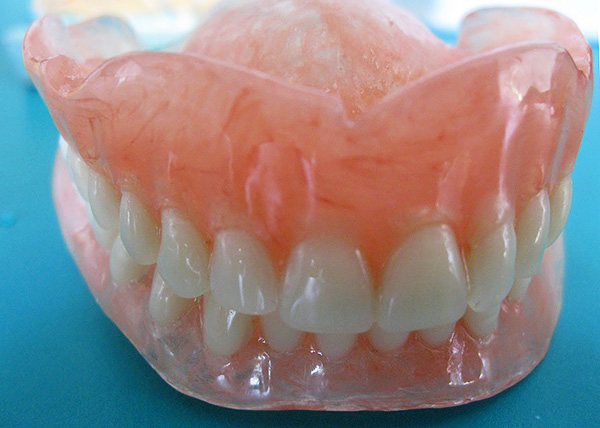
However, for all its advantages, nylon prostheses retain a number of disadvantages, which are useful to know in advance (in many ways, these defects are characteristic of complete removable dentures in general):
- Gradual atrophy of the prosthetic bed. In the complete absence of teeth, the alveolar ridges, experiencing an uneven load from the prosthesis, strongly “sag”. The process can take years, but is almost inevitable;
- Quite a quick loss of aesthetic qualities. Over the years, it is possible to change the color of the prosthesis, which sooner or later will require replacement of the product;
- Repairing a nylon prosthesis (unlike acrylic) is practically impossible - it will be easier to make a new product.
It is interesting
Thanks to prostheses, Acry Free managed to combine the positive properties of acrylic and nylon prostheses, getting rid of a number of disadvantages that create obstacles to free prosthetics with acrylic and nylon. Acre-fri has good adhesion ("adherence") to the mucous membrane, which improves the possibility of fixation in the complete absence of teeth on the upper and lower jaw. The prosthesis is lightweight, non-allergenic, able to correct, and most importantly - to a lesser extent provokes the phenomenon of atrophy of the alveolar bone.
The photo below shows the Acry-Free prosthesis:
Features of prosthetics with conditionally removable structures
Against the background of the foregoing, a number of well-founded questions arise:
- Are such methods of fixation of complete dentures, such as "suction" and anatomical retention (retention due to anatomical formations), sufficient for reliable fastening of the structure in the oral cavity and comfortable use?
- Is it possible to somehow improve the reliability of fixation of the prosthesis and increase the degree of comfort when wearing it?
Active people of advanced age are especially important not only beautiful, but also reliably "sitting" dentures that can chew almost any food normally.
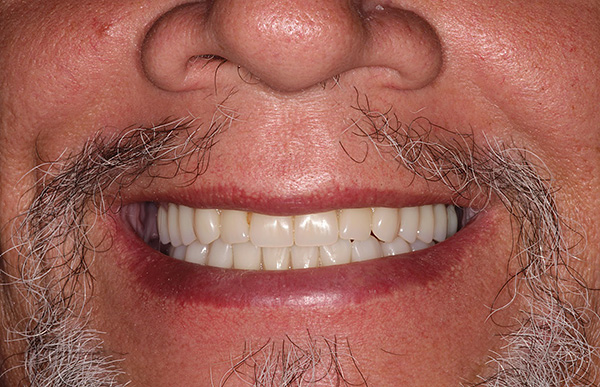
From the practice of the dentist
Not all patients have the patience to use a removable prosthesis, which, although it does not “rub”, does not “squeeze”, does not “crush”, but in the oral cavity there is still a sensation of the presence of a foreign object. And the most unpleasant thing is that there is no certainty that this “foreign object” will suddenly not fall out of your mouth, for example, when you sneeze ...
Significantly removable prosthetics with fastening the prosthesis on implants provides significant assistance in the reliable fixation of complete dentures. The use of dental implants makes it possible not only to significantly reduce the future prosthesis in size, making it as comfortable and easy to use as possible, but also completely eliminates the option of “sticking” the prosthesis during chewing or talking.
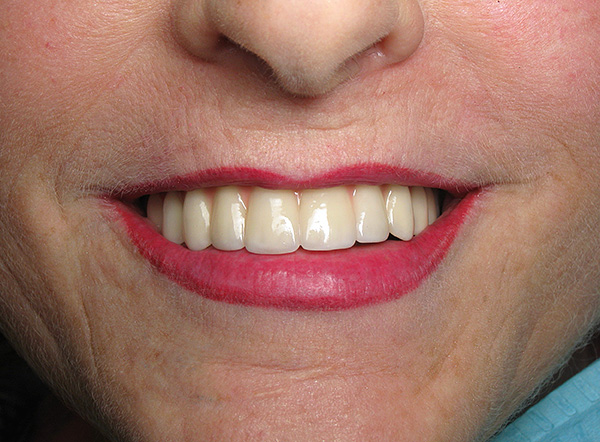
Currently, there are various types of implantation systems in order to fix a removable prosthesis:
- Classic - classic implants are placed in the spongy bone of the alveolar processes. Typically, prosthetics are stretched for several months, while the implants take root in the bone tissue;

- Basal - in a dense bone, located deeper than the spongy bone, basal implants are installed. In this case, even with significant atrophy of the bone of the alveolar processes, there is no need to increase it (that is, sinus lift surgery is usually not required);

- Mini-implantation - in this case, narrow mini-implants are installed in the bone, designed to fix the prosthesis. Unlike classical and basal implants, mini-implants are not designed for a significant load, so a complete prosthesis should also distribute the load to other parts of the oral cavity (palate, gum).

By methods of fixing complete removable dentures on implants, a significant niche in orthopedic dentistry is occupied by:
- Micro-locking;
- Beam fasteners;
- Magnetic clamps;
- Spherical (spherical) types of fastening;
- Silicone rings;
- Combined options.
On a note
Pre-installation of implants makes complete removable prosthetics as reliable and comfortable as possible, especially in difficult cases (with significant atrophy of the alveolar ridge, cords, etc.), when wearing almost any prosthesis (acrylic, nylon, acre-free) promises endless trips to the dentist - an orthopedist, torment during addiction and, as the most extreme option, sending a “puller” to the shelf.
Beam fixation on classical or basal implants is considered one of the most reliable and durable - it provides a reliable fit and fixation of the prosthesis, even under non-ideal conditions of prosthetics.
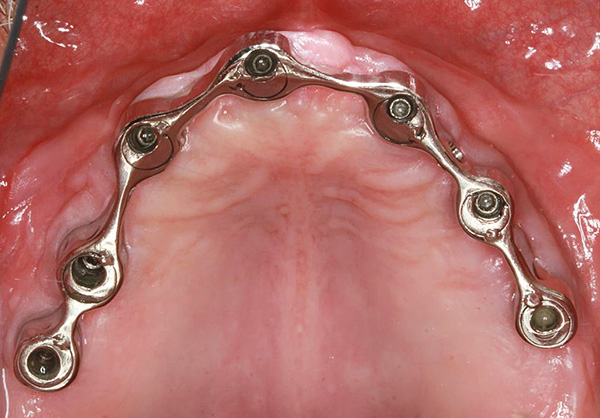
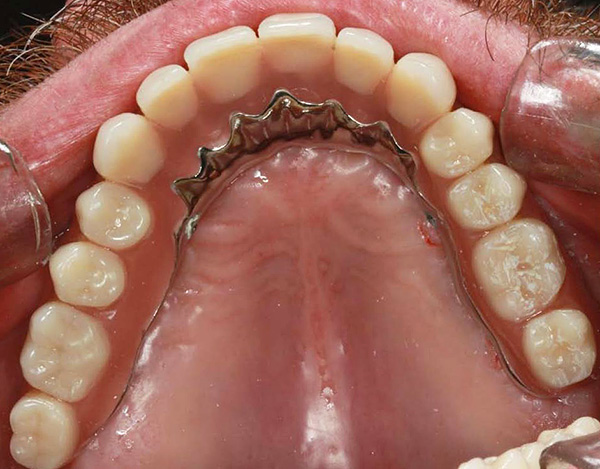
Magnetic retainers (attachments) hold the prosthesis due to magnetic attraction. This mounting option compared to other methods does not provide maximum reliability in holding the prosthesis.
As for the spherical attachments, some experts say that materials of this type of fastening tend to wear and fail (although there are systems that have replaceable washable parts - replacing them does not require a lot of time and money).
Currently, mini-implantation is actively used (and is being promoted in advertising by many clinics) to fix dentures on the toothless jaw, however, some experts believe that mini-implants are suitable only for temporary prosthetics, but not for permanent ones. Dental mini-implants differ from other simplified versions of surgical and orthopedic protocols, as well as low cost. They can be installed even in those clinical cases when the use of classical implants is impossible without additional preparatory operations, which can be difficult to tolerate or contraindicated, especially in old age.
As for implants installed on implants, they can be made from all the same materials as removable dentures (usually from nylon, Acre-free, polyurethane).
The principles of manufacturing complete removable dentures and their installation in the oral cavity
One of the most important stages of prosthetics is the examination of the patient - it includes the study of the state of general health, possible allergies to certain drugs (materials), as well as the assessment of the condition of the prosthetic bed in many ways.
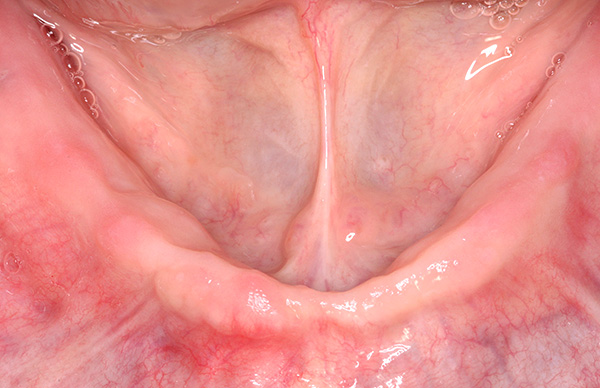
Much attention is paid to assessing the degree of atrophy of the alveolar processes in the upper and lower jaw. The condition of the mucous membrane is checked: mobility, color, "friability", the state of folds along the crest and other points. All this allows us to clarify the important nuances of the design of the future prosthesis.
Below on the example of a complete removable denture made of acrylic plastic, the main stages of manufacturing this design are considered:
- Imprinting and sending them to the laboratory for dental technicians;
- Casting models;
- Making individual spoons (as needed);
- Creating a base with bite rollers;
- Determination of central occlusion using these wax rolls;
- Production of a basis for bite rollers (relief modeling);
- Setting teeth on glass or on a plane;
- Gypsum model;
- Evaporation of wax;
- Mixing and "packing" of plastic;
- Finishing the prosthesis;
- And finally, the delivery of the prosthesis to the patient is a fitting in the oral cavity.
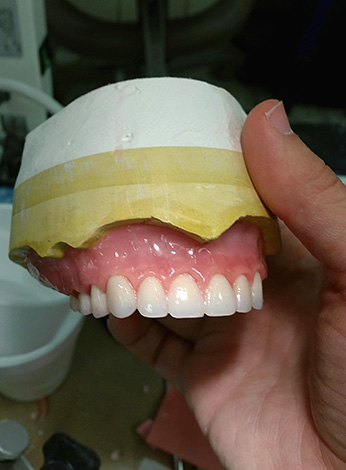
It is interesting
Standard removable acrylic dentures are made as follows: liquid material is poured into the mold, where it polymerizes and hardens. In the process of this, a large shrinkage of the material occurs, that is, a decrease in its volume, as a result of which the prosthesis may not correspond to the prosthetic bed and may not adhere accurately to it. In addition, micropores often form in the base, where bacterial plaque will accumulate in the future, causing bad breath.
The new technique for creating acrylic prostheses using the IVOCAP system (Ivocap) of the IVOCLAR company (Switzerland) eliminated these problems by injection molding - the plastic is dosed with capsules and pressed under constant pressure and temperature. With this manufacturing method, the characteristics of the prosthesis are improved.
How to care for a denture so that it lasts longer
After the patient receives a complete removable denture, the orthopedic surgeon always gives explanations about the nuances of his fixation in the oral cavity, and sometimes also teaches special speech exercises for quick adaptation to the product. Much attention is also paid to the rules for prosthesis care in order to increase its service life and minimize loss of aesthetics.
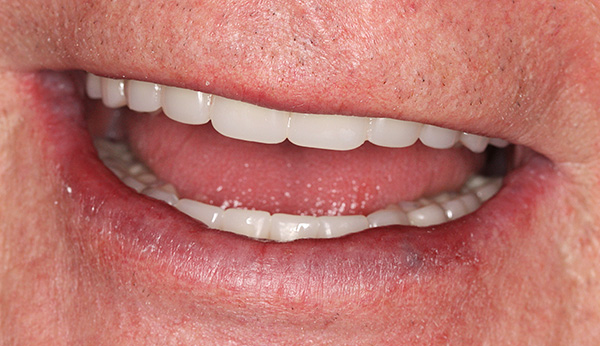
It's important to know
Complete removable dentures need daily cleaning, if only because they are tight to the mucous membranes and create areas that are poorly washed by saliva.
The most common care products for complete dentures:
- Cleansing tablets and powders (dissolved in water, after which a prosthesis is placed in the resulting solution);


- All kinds of ready-made solutions for the disinfection of dentures;
- Brushes for cleaning the prosthesis;
- Toothpastes (standard ones are suitable, the main thing is not to use whitening highly abrasive pastes, as they can lead to abrasion of plastic).
Standard prosthesis care scheme:
- In the morning and evening, clean off food particles and bacterial plaque using toothpaste and a brush. In this case, attention should be paid to cleaning not only the external surface of the prosthesis, but also the internal, which is in contact with the gum and palate;
- Rinse your mouth after each meal and rinse the prosthesis under running water;
- Clean the prosthesis before bedtime using special solutions.
It may seem surprising to someone, but plaque and even tartar can also be deposited on dentures, so it’s useful to go for preventive examinations at least once a year. In case of significant contamination of the prosthesis, he is given to a dental laboratory where the dental technician processes the prosthesis to the ideal state.
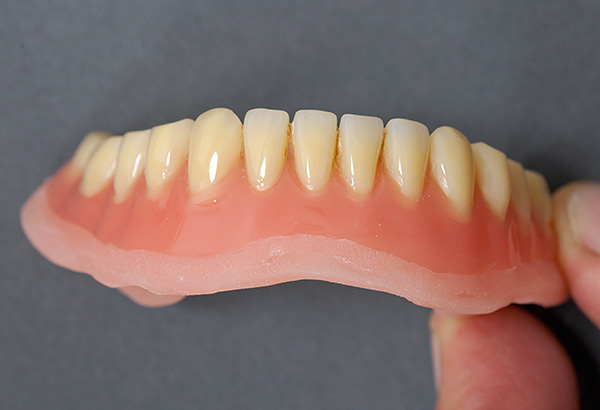
Proper care of the prosthesis is the key not only to its long service, but also an important factor that determines the health of the mucous membranes, the absence of putrid odor from the mouth and the preservation of aesthetic characteristics (You don’t want the artificial teeth of the prosthesis to turn brown and the plastic to become unnatural for the gums?)
How much is the complete "puller" now?
The cost of a complete denture is determined by a number of factors, among which the most important are the following:
- The material from which the denture is made (for example, an acrylic prosthesis will be cheaper than a nylon prosthesis);
- The presence in the clinic of their dental laboratory;
- Staff qualification level;
- Territorial location of dentistry (prices in megacities are usually higher than in small cities);
- Individual characteristics of the patient (some anatomical nuances may complicate the manufacture of a quality prosthesis).
To put it simply, today, only full removable dentures made of ordinary acrylic plastic are relatively cheap - their use is considered the most budgetary option for complete prosthetics.
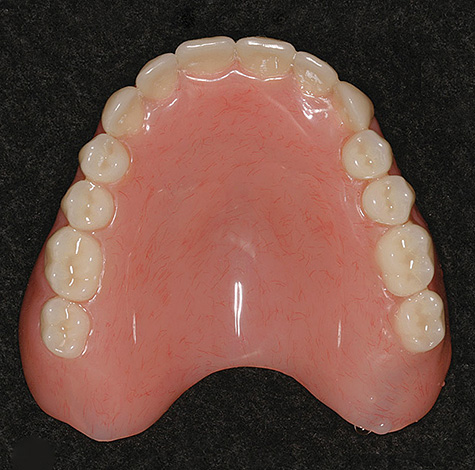
Feedback
“Only 2 weeks I wear the upper and lower prosthesis made of acrylic. The upper one sits wonderfully, and the lower one walks. One has only to move his tongue, as the prosthesis rises immediately. I don’t even know what this is connected with ... "
Inna, Moscow
Here are examples of prices for full dentures in one of the clinics in St. Petersburg:
- Acrylic prosthesis - from 8 thousand rubles;
- A prosthesis from Dentalur - from 12 thousand rubles;
- Lamellar prosthesis (Ivoclar plastic) - from 14 thousand rubles;
- Nylon prosthesis - from 20 thousand rubles;
- Nylon prosthesis (materials manufactured in Germany), Acre Free - from 25 thousand rubles;
- Removable prosthesis (materials manufactured in Switzerland) "Kandulor" - from 40 thousand rubles.
The combination of orthopedic and surgical care many times increases the price of treating a patient with complete absence of teeth - when it comes to conditionally removable prosthetics, the cost of implantation itself makes the main contribution to the final price.
If you have personal experience using a removable denture in the complete absence of teeth on the upper or lower jaw - please share the information by leaving your review at the bottom of this page (in the comments box).
What is important to know about nylon dentures (this is not spoken about in advertising)
Interesting nuances of full removable projection

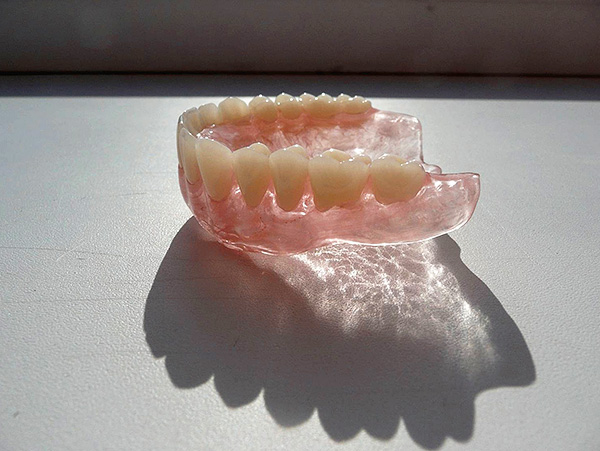
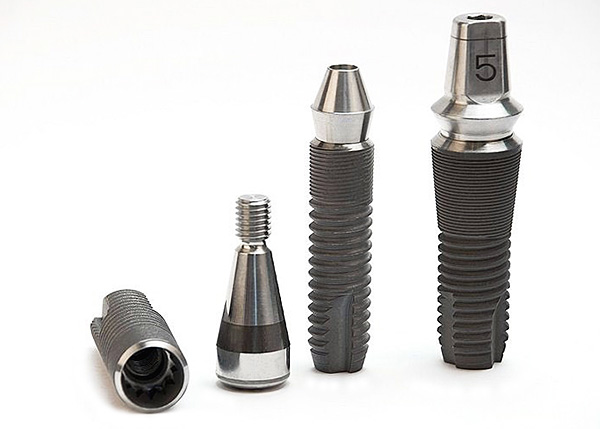
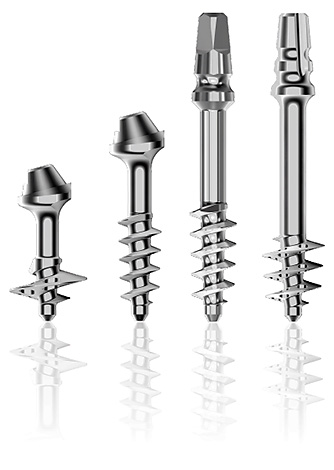
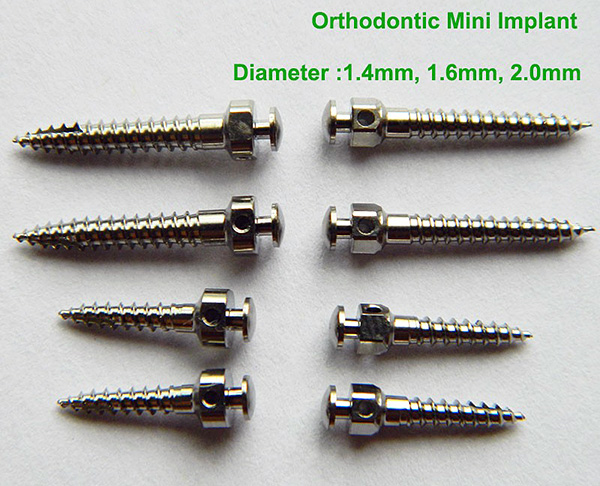
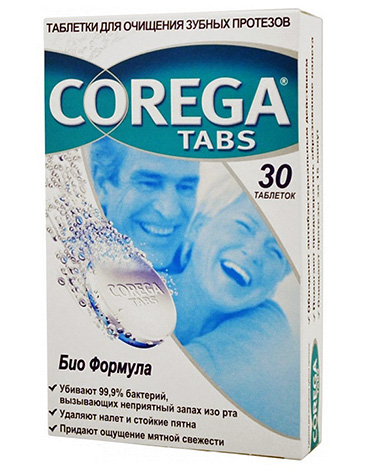
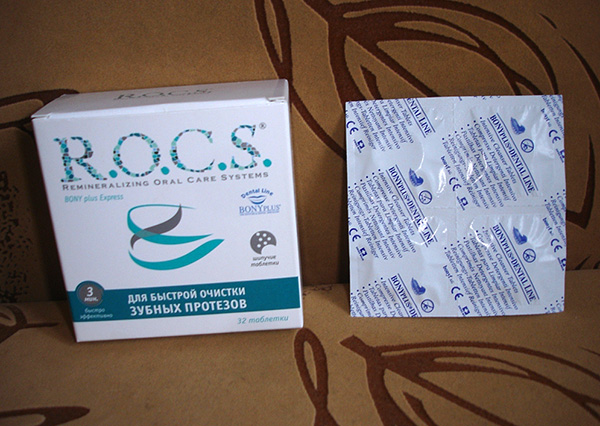
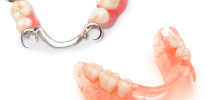
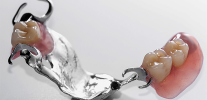
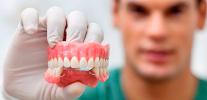
I have an upper and lower prosthesis. They put it to me 20 years ago. At night I never take off, I brush like ordinary teeth. Never flew, never lisped never. The only thing is that when the seeds were snapped, a dent in the tooth formed. So I'm very happy with my teeth. And yet, 20 years ago I set it, very cheap. And now, not everyone can insert their own teeth.
What prosthesis did you put?
On May 15, 2018, she inserted an acrylic removable denture on the upper jaw. My impressions: when talking, the prosthesis “walks”, lisps, the bite is changed and uncomfortable to me. The price of the prosthesis is 20,000 rubles. The money is not crazy, but I really want a comfortable prosthesis. I think maybe in another clinic to order a new one. Prosthetized at the CMSC-38.
I wanted to insert a prosthesis on the upper jaw. Alfa Bank refused. Just something needed 30,000.
Put an acrylic prosthesis - horror! Everything interferes, I want to quickly remove it.
So I have the same, also the teeth look like horses.
For 12 years I have been wearing removable dentures. At first they were partial, but now I will order complete ones, since there are no teeth left. My dentures are acrylic. Perhaps because my gag reflex is poorly expressed, I didn’t get used to them for long, about a couple of weeks, although the doctor warned that I would get used to the month for sure. Now I’m thinking which material to choose. Still, acrylic is quite tough. Although I did not experience any particular problems when wearing them. Sunflower seeds, of course, did not click, but chewed quite solid food.
They made an acrylic full denture on the upper jaw. Inconveniently. Vomiting reflex. But I endure. I understand that it takes a long time to get used to and be patient. Disappointed in aesthetics. Some teeth are long, or just sit below. Like a rabbit. I didn’t like it. Theirs were smaller and with a smile, the gums were not visible. And now, like a horse ((
The first day without a single tooth. The sponges have failed. Aged by 15 years. I read reviews about prostheses - ultramodern I can not afford. Acrylic probably pull. And as I imagine that I have to put this in my mouth, it makes me sick. Just now you understand that you need to take care of your teeth and treat on time.
She put an acrylic full denture on top. On the contrary, my teeth became small, it is not visible at all with a smile. And in general, it hurts to smile - the prosthesis closes the septum (or as it is called, from the inside of the lip). The old prosthesis was wider than the lower one, but this one, on the contrary, was smaller. I can’t wait for the night to take off. I put it before the New Year, and I don’t even know how to explain to the orthopedist what is wrong. Specialists, advise, please.
Hello, Natalia! If the prosthesis was incorrectly made in size, then I can’t reassure anything - the convenient position of the product, its width and length can be adjusted only by making a new prosthesis.
But the problem with overlapping and inconvenience in the frenum of the upper lip can be solved by simple correction of the prosthesis. For correction, you should contact your doctor (orthopedist dentist) and just explain everything in your own words: it’s painful to smile, that the prosthesis rests on the septum from the inside of the lip. A good doctor understands everything at a glance.
Removable acrylic dentures can be used only in the most hopeless position. It is inconvenient, unusual to remove and paste - it rubs somewhere, prevents you from speaking, taste sensations are lost. Think 10 times.
I want dad to put dentures. Please advise which ones are better? Money for the pope is not a pity, the main thing is that he should be convenient and comfortable.
Hello Nazgul! The fact is that the best prosthetics option is always determined only during a personal examination by an orthopedic dentist and largely depends on the patient’s oral cavity condition (how many teeth have been preserved, what condition they are in, etc.) So it’s just so to say that the best an option is a clasp prosthesis or laminar prosthesis would be incorrect.
Before the new year, I put a removable prosthesis made of acrylic plastic on the upper jaw with a complete absence of teeth. My dears, I have experienced such depression while removing my last roots. I was very worried that there would be a removable prosthesis ((But they set it, and I am very happy! All my life I was tormented, healed, treated from the school bench, then metal-ceramic bridges (20 years ago it cost a lot of money and effort). In general, do not be afraid, the main thing is that everything is fine, I’m used to the prosthesis in a week. Of course, I ran about a week, clean it up a little, then there. Terlo at first, but now I’m very happy! And aesthetics, your teeth are short or long - you go to try on ask for what you want, tell your doctor about it. I’m perfect in color and length I’ve picked it up. Now the time has come for the lower jaw, I'm worried again (everywhere they write that the lower removable denture does not hold, and my health does not allow for implants, and there is no time and money).
Tell me, share your opinion: is everything really so hopeless without implants?
The situation with fixation on the lower jaw directly depends on the degree of atrophy of the alveolar ridge (gums). In addition, if necessary, you can always use special tools to fix the prosthesis, so the situation is in any case not hopeless.
You can also consult with several implantologists regarding immediate implantation techniques - they have fewer health restrictions and lower costs.